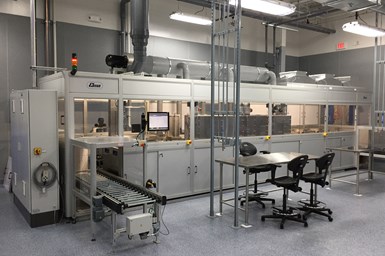Non-Machining Processes Worth Considering
Here are three in-house processes outside of machining parts from which your shop, employees and customers could benefit.
#columns #additive

This is a nitric and citric passivation system with fume extraction for the nitric tanks and HEPA fan filter units above the dryer for cleanroom environments.
Machines making chips make machine shops money. But ancillary production processes are often required to complete the manufacture of parts, subassemblies or products for customers. It sometimes makes sense to outsource some of those processes to trusted vendors. In some cases, though, bringing select processes in-house might enable shops to lower production costs and shorten delivery times while ensuring quality.
Passivation of stainless steel is one such process that an increasing number of shops are bringing in-house, or at least considering doing so, and this article answers frequently asked questions about adding that capability.
Featured Content
But, beyond finishing operations such as passivation, are there other non-machining processes that might be worth bringing in-house? Here are three to consider:
3D printing. Shops seem to be paying attention to this technology, but not all are taking advantage of it. In terms of production of metal parts, it offers distinct advantages in its capability to create complex geometry and internal features that would be challenging, if not impossible, to machine. Still, it can’t come close to the production volume of equipment such as multi-spindles or rotary transfer machines that can drop completed metal parts every few seconds.
However, there can be benefits to purchasing a low-cost 3D polymer printer. I’ve visited a number of shops that print tooling, fixturing, jigs, robot end effectors and so on for use on the shop floor. These are components that otherwise would be machined and assembled in a shop’s tool room. But, because most shops have CAD/CAM software, it’s possible to design those components and have the 3D printer build the parts layer-by-layer on its own, perhaps during off-hours. Of course, this is an oversimplification of the process as there’s more to just pressing “go” on a 3D printer, but this alternate method still might be a better choice to manufacture shopfloor gizmos like those mentioned above in the most expedient way. In fact, the photo below shows an interesting CMM fixture in which all the main components were created during the same print and then assembled. Metal 3D printers are also an option for shopfloor applications such as those that require higher wear resistance than polymers, but those devices can be pricey.
Vacuum forming. I remember visiting a medical shop that machined plastic cases that served as dental kits holding a family of titanium implantable components. Those cases were also laser marked in-house and the kits were assembled in the shop’s clean room.
Similarly, I know shops that purchase generic, plastic trays to ensure machined parts don’t contact each other during delivery. But why not use a vacuum forming machine to create your own custom trays to best match the shape and contour of customers’ parts or subassemblies?
For this process, a heated plastic sheet is placed over a form and a vacuum is applied to pull the sheet down tightly against the form to create the tray shape. Shops with milling capability can easily make forms out of aluminum blanks (or wood, for that matter, if they want to deal with the dust). It would also be possible for shops to add company branding to the packaging to help further keep their name in front of customers.
Product assembly. At first blush, this might not be a process shops feel they outsource. But they do. To their customers. Adding staff and equipment to provide customers with subassemblies, not just precision-machined parts, makes a shop a more valued resource while reducing the burden of product assembly for its customers. That this can represent yet another shop profit center isn’t a bad thing, either. Plus, young people who feel they don’t have the chops to operate a machine tool might not apply for those types of job openings. But those who are good with their hands might be intrigued by assembly work. And, once brought onboard to fill a shop’s open assembly position, maybe they eventually realize that operating a machine tool is something they can do after all…
RELATED CONTENT
-
Get to Know Cleanliness Standards
With a small amount of practice, it is possible to understand the underlying motivation of a cleaning standard and to figure out the specific aspects of the specification that are applicable to the customer.
-
4 Advantages of Acquiring Another Machining Business
Opportunities to expand CNC machine shop businesses via acquisition come with advantages that manifest themselves in terms of customers, employees, production technologies and business practices.
-
The Basics of Cleaning with a Parts Washer
Better Engineering answers the question of “What do I need to know about an aqueous parts washer and its process?”






